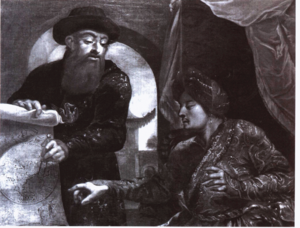Johann Adam Schall von Bell facts for kids
Quick facts for kids
Johann Adam Schall von Bell
|
|||||||||
|---|---|---|---|---|---|---|---|---|---|
 |
|||||||||
| Born | 1 May 1591 Cologne or Lüftelberg, Holy Roman Empire
|
||||||||
| Died | 15 August 1666 (aged 75) Jingshi, Shuntian, Zhili, Qing China
|
||||||||
| Alma mater | Collegium Germanicum, Gregorianum | ||||||||
| Scientific career | |||||||||
| Fields | Astronomy, religion | ||||||||
| Chinese name | |||||||||
| Traditional Chinese | 湯若望 | ||||||||
| Simplified Chinese | 汤若望 | ||||||||
|
|||||||||
| Manchu name | |||||||||
| Manchu script | ᡨᠠᠩ ᡰ᠊ᠣ᠋ ᠸᠠᠩ | ||||||||
| Romanization | tang žo wang | ||||||||
Johann Adam Schall von Bell (born May 1, 1591 – died August 15, 1666) was a German Jesuit priest, astronomer, and someone who made scientific tools. He spent most of his life as a missionary in China. There, he was known as "Tang Ruowang." He became a trusted helper and adviser to the Shunzhi Emperor, who ruled China during the Qing dynasty.
Contents
Early Life and Studies

Johann Adam Schall von Bell was born in a noble family in Cologne, a city in what was then the Holy Roman Empire. After finishing high school at a Jesuit school in Cologne, he moved to Rome. In Rome, he studied important subjects like mathematics and astronomy at the Collegium Germanicum.
In 1611, he joined the Society of Jesus, also known as the Jesuits. This is a religious group within the Catholic Church. He continued his studies at the Gregorianum, another famous university.
Journey to China
In 1618, Schall von Bell began a long journey to China. He traveled on a Portuguese ship with other missionaries. The next year, they arrived at Macau, a Portuguese trading port. Schall von Bell spent time there learning the Chinese language.
He started his missionary work in China in 1622. That same year, he helped defend Macau from an attack by the Dutch. He even captured a Dutch captain during this battle.
Working on the Chinese Calendar
In 1630, Schall von Bell and another Jesuit, Giacomo Rho, were sent to Beijing. Their job was to continue the work of a Jesuit named Johann Schreck. They were tasked with improving the Chinese calendar.
Working with a Chinese scholar named Xu Guangqi, they helped create a new calendar. It was called the Chongzhen calendar, named after the Chongzhen Emperor. He was the last emperor of the Ming dynasty. This new calendar was much better at predicting things like eclipses of the sun and moon.
Schall von Bell also helped the Ming dynasty by making cannons. His workshop in Beijing is said to have produced about 500 cannons.
Adviser to the Emperor
After the Ming dynasty fell in 1644, the Qing dynasty took over. Schall von Bell became close to the new ruler, the Shunzhi Emperor. He became one of the emperor's most trusted advisers.
He was given an important job as a "mandarin," which was a high-ranking official. He became the Director of the Imperial Observatory and the Tribunal of Mathematics. This meant he was in charge of studying the stars and planets for the emperor.
Because of his important position, Schall von Bell was able to get permission for Jesuits to build churches and teach about Christianity across China. Many Chinese people were baptized by Jesuit missionaries during this time.
Challenges and Later Life
When the Shunzhi Emperor died in 1661, Schall von Bell's position became less secure. In 1664, he was accused by a Chinese official named Yang Guangxian and some Muslim astronomers. They claimed he was planning a rebellion and had made mistakes in calculating important dates.
Schall von Bell and other Jesuits, including Ferdinand Verbiest, were put in prison. While in prison, Schall von Bell had a stroke. They were all sentenced to death. However, after an earthquake, they were pardoned. Only five Chinese Christians who worked in the astronomy office were executed. The Jesuits were sent away to Macau.
Schall von Bell died less than a year after being released from prison. He was buried in the Jesuits' Zhalan Cemetery in Beijing.
Later, the young Kangxi Emperor replaced Yang Guangxian with Verbiest. Schall von Bell's good name and honors were fully restored.
Meeting with Prince Sohyeon
Crown Prince Sohyeon was the first son of King Injo of the Korean Joseon dynasty. He was held as a hostage in China. He was very interested in Western science and visited Schall von Bell.
Schall von Bell gave the prince books about Western science and the Catholic faith. The prince was very interested. Sadly, Prince Sohyeon died suddenly in 1645 when he returned to Korea. This ended Schall von Bell's hope of spreading Jesuit missionary work into Korea.
Lasting Impact in China
Schall von Bell is still remembered in China today. In 1992, Taiwan issued a special stamp to celebrate 400 years since his birth. It noted that his place in Chinese history is very important.
In 2013, Chinese CCTV, a major TV channel, made a documentary about him. The film mentioned that the Chongzhen calendar he helped create is still used today. He also appears in Chinese TV shows, especially those about the palace, because he was close to the Shunzhi Emperor.
Images for kids
-
Jesuit astronomers with the Kangxi Emperor.
See also
 In Spanish: Johann Adam Schall von Bell para niños
In Spanish: Johann Adam Schall von Bell para niños
- Religion in China
- Jesuit China missions
- Christianity in China
- Christianity in Korea


